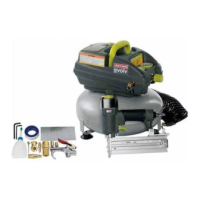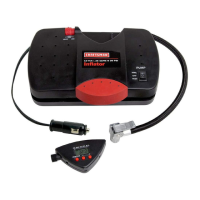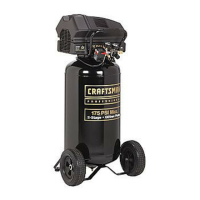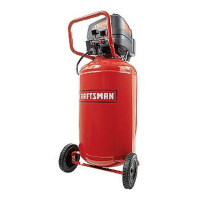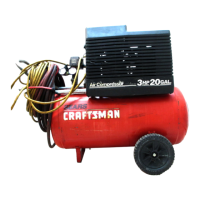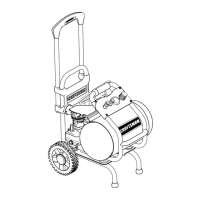Operating Procedures
Daily Start=Up Procedures
1. Set the Auto-On/Off switch to the Off position.
2. Inspect the air compressor, air hose, and any
accessories/tools being used for damage or
obstruction. If any of these mentioned items are in
need of repair/replacement, contact Sears or
another qualified service dealer before use.
3. Close the drain valve.
4. Connect the air hose to the quick connect socket
on the regulator assembly by inserting the quick
connect plug on the air hose into the quick
connect socket. The quick connect socket collar
will snap forward and lock the plug into place
providing an air tight seal between the socket
and plug. To release the air hose push the collar
back on the quick connect socket.
5. Plug the power cord into the proper receptacle.
6. Turn the Auto=On/Off switch to the On-Auto
position and the compressor will start and build
air pressure in the tank to cut-out pressure and
then shut off automatically.
7. Adjust the regulator to a PSI setting that is needed
for your application and be sure it is within the
safety standards required to perform the task. If
using a pneumatic tool, the manufacturer should
have recommendations in the manual for that
particular tool on operating PSI settings.
8. The air compressor is now ready for use. The
following inflation and cleaning accessories
packaged with this unit should only be operated
at maximum pressure of 90PSI: Blow gun,
adapter and inflation needle.
NOTE: See Accessory Kit Guide for more
information on attachment instructions.
I
®
Daily Shut=Down Procedures
1. Set the Auto=On/Off switch to the Off position.
2. Unplug the power cord from the receptacle.
3. Set the outlet pressure to zero on the regulator.
4. Remove any air tools or accessories.
5. Open the drain valve allowing air to bleed from
the tank. After all of the air has bled from the
tank, close the drain valve to prevent debris
buildup in the valve.
When draining the tank, always use ear and eye pro-
tection. Drain the tank in a suitable location; con-
densation will be present in most cases of draining.
Water that remains in the tank during storage will
corrode and weaken the air tank which could cause
the tank to rupture. To avoid serious injury, be sure
to drain the tank after each use or daily.

